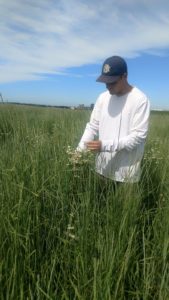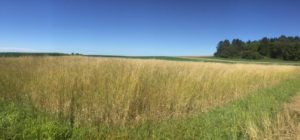Into The Weeds
A summary of the paper entitled Effective weed suppression in dual‐use intermediate wheatgrass systems
By: Joe Zimbric

In September of 2015 a small quarter acre section of the University of Wisconsin–Madison Arlington Agricultural Research Station was planted with a cycle 4 variety of Kernza® intermediate wheatgrass. At that time, the small planting represented the first of what would become many Kernza® research trials in the state of Wisconsin. My advisor, Valentin Picasso, and Wes and Joan Jackson christened the new planting later that fall. This “first” experiment became the site of our initial research into Kernza®’s weed suppression capabilities.
Since herbicides are not currently labeled for use in Kernza® production systems, we wanted to figure out how weed competition might impact the production of this new crop. From an ecological point of view, dual-use Kernza® production systems impose a very unique set of selection pressures on weed communities compared to annual grain production systems. Due to Kernza®’s deep fibrous rooting system, continuous living cover aboveground, and aboveground disturbances through frequent forage harvests, annual weeds that are common in our typical annual grain systems have almost no ability to persist in this type of environment.
With that in mind we hypothesized that we would observe both a reduction in aboveground weed productivity during the duration of the stand and that we would see a transition to a weed community composed primarily of perennial species. Both of these hypotheses were ultimately confirmed by our data. In our recently published paper in Agronomy Journal, our two key findings showed that over a three-year period, aboveground weed biomass was reduced by 88%, and the weed community composition changed from annuals to primarily perennial weed species. While these results are encouraging, we do acknowledge that they are somewhat site specific and not necessarily transferable to all locations.

Organically managed Kernza® production systems will be vulnerable to winter annual weed

infestations in the first year after establishment. We’ve observed high densities of Shepherd’s purse, Field pennycress, and Horseweed (all winter annual species) in almost all of our stands in the spring after fall Kernza® establishment. Though we didn’t encounter this particular problem during our research, we anticipate organically managed Kernza® systems will also be vulnerable to infestations from difficult to control perennial weeds such as Canada thistle and perennial cool season grass species. When these invasions occur, effective organic weed management options will be very limited, therefore planting Kernza® into fields free of these perennial weeds is recommended.
About the author: Joe Zimbric was a member of the Forages and Perennial Grains Lab at the University of Wisconsin-Madison from 2017 to 2019 where he was advised by Dr. Dave Stoltenberg and Dr. Valentin Picasso. Currently, Joe works with the University of Wisconsin-Madison Division of Extension as an Outreach Specialist in Dodge and Fond du Lac counties.
Read the full paper here: https://doi.org/10.1002/agj2.20194